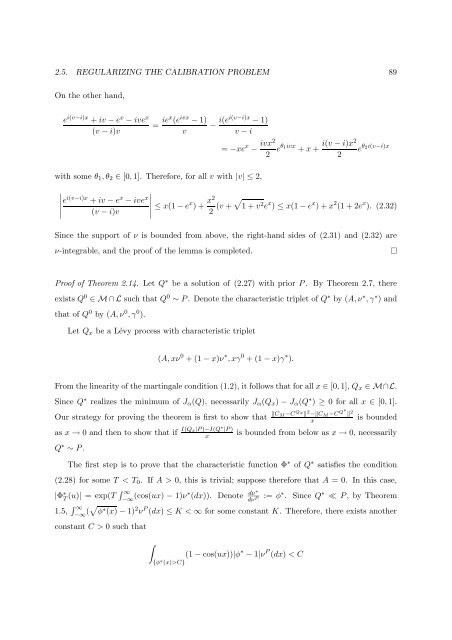Processus de Lévy en Finance - Laboratoire de Probabilités et ...
Processus de Lévy en Finance - Laboratoire de Probabilités et ...
Processus de Lévy en Finance - Laboratoire de Probabilités et ...
Create successful ePaper yourself
Turn your PDF publications into a flip-book with our unique Google optimized e-Paper software.
2.5. REGULARIZING THE CALIBRATION PROBLEM 89<br />
On the other hand,<br />
e i(v−i)x + iv − e x − ive x<br />
(v − i)v<br />
= iex (e ivx − 1)<br />
v<br />
− i(ei(v−i)x − 1)<br />
v − i<br />
= −xe x − ivx2<br />
2 eθ 1ivx + x +<br />
i(v − i)x2<br />
e θ 2i(v−i)x<br />
2<br />
with some θ 1 , θ 2 ∈ [0, 1]. Therefore, for all v with |v| ≤ 2,<br />
e i(v−i)x + iv − e x − ive x<br />
∣ (v − i)v ∣ ≤ x(1 − ex ) + x2<br />
2 (v + √ 1 + v 2 e x ) ≤ x(1 − e x ) + x 2 (1 + 2e x ). (2.32)<br />
Since the support of ν is boun<strong>de</strong>d from above, the right-hand si<strong>de</strong>s of (2.31) and (2.32) are<br />
ν-integrable, and the proof of the lemma is compl<strong>et</strong>ed.<br />
Proof of Theorem 2.14. L<strong>et</strong> Q ∗ be a solution of (2.27) with prior P . By Theorem 2.7, there<br />
exists Q 0 ∈ M ∩ L such that Q 0 ∼ P . D<strong>en</strong>ote the characteristic tripl<strong>et</strong> of Q ∗ by (A, ν ∗ , γ ∗ ) and<br />
that of Q 0 by (A, ν 0 , γ 0 ).<br />
L<strong>et</strong> Q x be a Lévy process with characteristic tripl<strong>et</strong><br />
(A, xν 0 + (1 − x)ν ∗ , xγ 0 + (1 − x)γ ∗ ).<br />
From the linearity of the martingale condition (1.2), it follows that for all x ∈ [0, 1], Q x ∈ M∩L.<br />
Since Q ∗ realizes the minimum of J α (Q), necessarily J α (Q x ) − J α (Q ∗ ) ≥ 0 for all x ∈ [0, 1].<br />
Our strategy for proving the theorem is first to show that ‖C M −C Qx ‖ 2 −‖C M −C Q∗ ‖ 2<br />
x<br />
is boun<strong>de</strong>d<br />
as x → 0 and th<strong>en</strong> to show that if I(Qx|P )−I(Q∗ |P )<br />
x<br />
is boun<strong>de</strong>d from below as x → 0, necessarily<br />
Q ∗ ∼ P .<br />
The first step is to prove that the characteristic function Φ ∗ of Q ∗ satisfies the condition<br />
(2.28) for some T < T 0 . If A > 0, this is trivial; suppose therefore that A = 0. In this case,<br />
|Φ ∗ T (u)| = exp(T ∫ ∞<br />
−∞ (cos(ux) − 1)ν∗ (dx)). D<strong>en</strong>ote dν∗<br />
dν P<br />
:= φ ∗ . Since Q ∗ ≪ P , by Theorem<br />
1.5, ∫ ∞<br />
−∞ (√ φ ∗ (x) − 1) 2 ν P (dx) ≤ K < ∞ for some constant K. Therefore, there exists another<br />
constant C > 0 such that<br />
∫<br />
{φ ∗ (x)>C}<br />
(1 − cos(ux))|φ ∗ − 1|ν P (dx) < C
















